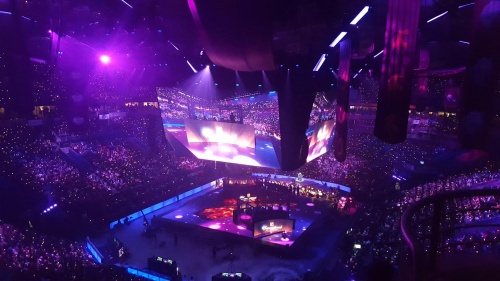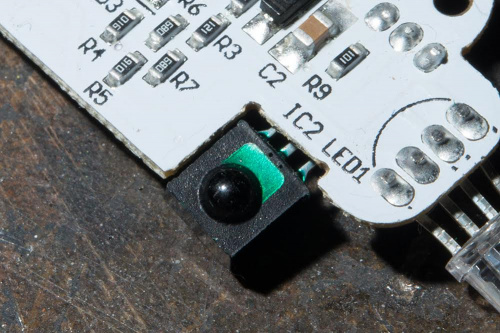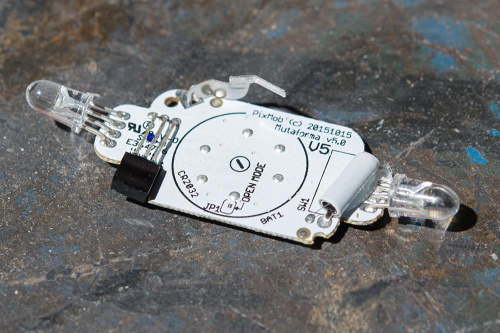In the first week of August my wife and I, along with a few friends of ours, decided to take a long trip up to Seattle. This vacation wasn't to sight-see and it wasn't to visit friends or family, no – it was to attend The International at Key Arena. The International is a tournament for the multiplayer, online battle arena (MOBA) video game Dota 2, where the best teams from around the world compete to claim a piece of the $20M prize pool (and mom always told us that playing video games wouldn't amount to anything). It took us close to 20 hours to get there, but it was a great event. Lindsay Sterling opened the show, there were upsets, there were stunning victories, and it was fun!
Here's the game stage, to give you an idea of the scale of this event.
Though we didn't compete, my group did have the pleasure of watching the week-long event. While at The International we received an unfathomable amount of swag. One item among the multitude intrigued me the most, and it was simply taped to the seat when we entered the arena. It was a small, white, crowd participation wristband that would light up when certain things happened during a game. The actions that set off the wristband included anything from the first blood (kill) of the match, a multi-kill, a special power being used or a team victory. We knew there were three LEDs inside and some sort of control circuit, but our biggest question was: How was it communicating? My group and I hypothesized simple and cheap wireless options, like the ESP8266, or some sort of geolocation system, but we couldn't come to a consensus. All we knew was that if we left the stadium it would cease to function.
The PixMob Mutaforma V5 Wristband
It wasn't until we were safely back home that I was able to actually research this little piece of plastic and rubber. I came to find out that the wristband is the Mutaforma V5 by a Montréal-based company called PixMob. These wristbands have been used in multiple, large crowd events like music concerts, Super Bowl half-time shows, E3 press conferences, the Olympics and corporate occasions.
Wristbands ON! Yes, the stage is a giant screen.
Working in a large, open-source community, I've grown accustomed to finding schematics and datasheets quickly and easily. Unfortunately, that was not the case with the Mutaforma V5. It is perfectly understandable that PixMob doesn't want their wristbands imitated by a rival company because, let's be honest, when you do shows for Taylor Swift, you want to hold onto your intellectual property. As for me, though, I needed to know what was inside.
Listen... It was like this when I found it...
Like I said, it was hard to find any information on how to get into this little piece of techno-entertainment, so I had to go about opening it the old fashioned way, with screwdriver and hammer. Luckily, it didn't take long.
A bit busy on the top side
Now that we cracked open the outer shell, we can see three LEDs (one SMT, two through-hole), a microcontroller, an assortment of tiny ICs (some passives and what looks like a VREG), and a generic IR receiver.
An MC81F4204 MCU and RGB LED
Let's take a closer look. The main chip on the Mutaforma V5 is an ABOV [MC81F4204](https://cdn.sparkfun.com/datasheets/Components/General IC/MC81F4204.pdf), a CMOS 8-bit MCU that provides 4K bytes of FLASH-ROM and only 192 bytes of RAM. The MC81F4204 is a very small chip that can surprisingly support its own weight, and makes for a reasonably cheap option for hand-outs. To its right is a simple, RGB LED. Between the three RGB LEDs provided on the board, we can assume that none of them are addressable, and to be fair it really isn't necessary. It's clear that this board has been designed from the ground up to be as simple and as cheap as possible. Quite effective, really.
THIS is how the people behind the scenes were able to communicate with the Mutaforma.
The biggest question I had about this board has been answered, and simply. All communication to the Mutaforma was controlled wirelessly via this little receiver. After doing a bit of poking around on PixMob's website, I learned the set-up they had in the arena was pretty simple. A technician manning the light board also controlled a wide array of IR emitters installed inside the seating area of Key Arena. Here's a pretty neat diagram of their set-up. This explains why the wristbands stopped functioning when we left the game floor to use the bathroom or to go to concessions.
Not as busy underneath.
Flipping the board over, we can see where the two through-hole LEDs and the IR receiver make their connections, the battery pad for two CR2032s, and what we initially thought was a crystal – a basic, motion-sensing tilt sensor. There are actually a couple of things to note on the underside of this board, both relating to the tilt sensor. First, when the events concluded at The International, one last command was given to each of the wristbands inside the arena that told them to permanently switch to motion-sensitive mode. Whenever you move the wristband after the event, the LEDs light up in a random assortment of colors. The second item on the back of this board that I found interesting is the small jumper located on the CR2032 battery pad. Once connected, the jumper forces the Mutaforma into motion-sensitive mode, which is great for people like me who didn't receive that last command from the light board.
And that's pretty much it! It's a very simple solution to get the audience involved in the ongoing event. It certainly got my wife and I to pump our fists every time the wristband flashed red and gold to signify a "first blood"...social engineering at its finest.














Cool teardown! I went to MLG Columbus and didn't really get any cool swag. More proof that Valve hates CS Go :-(
The amount of free stuff was tremendous. I think I walked away with five or six new shirts, and everything in the gift bag x2 since I had a midweek and finals badge. It was insane.
Maybe it just comes down to the fact that The International is a Valve sponsored event and MLG isn't?
The MLG major was a Valve sponsored $1 Million championship. There are other organizations that host Valve sponsored events, Valve gives the prize pool and who knows what else, and the coordinating and putting on of the event is a third party.
Also its kind of a theme that Valve doesn't really give CS Go much love. I think they haven't even advertised a CS Go Major on the Steam page until the most recent one.
CS:GO has no real true Superbowl type event. Maybe MLG and other tourneys should start crowd sourcing their prize pool, CS:GO can get away from the betting... Oh, whoops, too soon?
I think a majority of the community was against gambling with a few professional bad apples making the sport look bad. Do you think we like the stigma that 90% of the twitch playtime was people betting and opening cases? No, I want to see pros playing the game.
I have to agree. I think this is an occasion to hate the (certain) players, not the game.
I got 8 of a similar device from Dockercon. The ones that I have are Bluetooth LE. And yes there is an iPhone app for that. The daughter loves them!
Breakdown of a few
Daughter Dancing with them
That's awesome! It looks like they actually use addressable LEDs in their version. Is that the case?
All three leds light the same. But I can use the app to select the color of the set.. And in fact all the devices..
Ah, alright. Well, there is definitely something to be said for app connectivity!
I got two of those as well from TI6! I've been asked by friends to do some wireshark "hacking" to figure out the commands to send to it to do different things. I assume for each event, they load the MCU with different code for whatever the host wants it to do. My goal by the end of the year is figure out the IR command to call, "First Blood."
I'd be interested to see what you find out about it!
I noticed similar tech at Disneyland World of Color last week. There were head bands and mouse ears that would light in sync with the ferrous wheel. That would be another interesting teardown. I didn't buy one, but would assume internals were similar. The IP would almost certainly be locked down.
It's very likely, though it may be an internal group that makes the bits and bobs for Disney. I know PixMob makes firefly-type devices, huge orbs, and lanyards that all utilize the same tech. Needless to say I'd be willing to bet they use they same IR transmitting set up.
The animated Christmas lighting folks have figured out the Disney ones... http://doityourselfchristmas.com/forums/showthread.php?25142-Glow-with-OUR-Show-and-MSP430G2553-discussion&highlight=disney
Can you post a pic of how you closed the jumper?
Some labeling on the photos would have been nice. Take a leaf from Instructables! MSPaint should work enough. ; )
one nitpick: there's no such thing as a non-addressable WS2811. the WS2811 IC is what makes it addressable. what you have there, and the correct datasheet you linked, is a RGB LED in the very common 5050 package. WS2812 use the same package and includes a tiny WS2811 IC to make it addressable.
No worries, I prefer my work to be nitpicked. I like information to be as correct as possible! You are absolutely correct. I fixed everything, thank you!
There are other manufacturers of similar wristbands: - Glowmotion have a nice solution based on radio communication. They can enable some proximity effects and synchronize the wristband with smartphone of the user. - Xyloband has a basic type of wristbands. They were the first to do that kind of stuff in large stadiums I think (2012 Coldplay concerts). - CrowdSync Technology
Nice. I think I am mainly impressed by how the Mutaforma was controlled. If I ever encounter other manufacturers versions I'd love to break them open as well to see how they vary from each other.